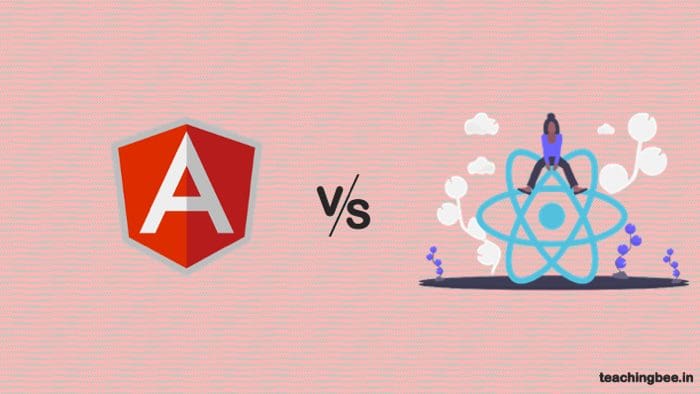Table of Contents
ToggleIntroduction
JavaScript is a client-side scripting language used to provide dynamic attributes as well as features to HTML web pages . JavaScript was created to assist the browser by enabling an asynchronous communication system, which controls the browser, and facilitating interaction between users and components of the web page.Angular Js vs React is one of the hottest topic these days which have left front end developers divided.
A HTML page is simply a static page. JavaScript could make the site more user-friendly and interactive, JavaScript helps easy navigation of the site and provide interaction. As various frameworks are being developed adding numerous new features for server-side scripting. Thus, javascript is gaining popularity in the world of web and if you examine the latest websites, you will not see any web-based technologies that is not using javascript.
In this post we will look into two trending javascript libraries and lay down some comparison between Angular Js vs React.
AngularJS
AngularJS is an open-source JavaScript framework that is maintained by Google and the community that allows developers to build single-page applications. AngularJS that are constructed on JavaScript makes the work of developers extremely easy.
The concept behind the use of AngularJS in web applications will make the application modular and simpler to maintain. Its aim is to aid in creating web applications that have models-view controller (MVC) capability to make maintenance, development and testing simpler. After using minified files within your application, its size decreases to around a few KB and makes loading pages quicker. AngularJS is great for developing high-activity and interactive web-based applications. This is by far the most widely used JavaScript framework for creating
AngularJS allows you to build web-based applications that are based in HTML, CSS, JavaScript. It is possible to create custom document Object Model (DOM) elements by using the AngularJS. Back-end communication is handled by views and controllers are crucial to the creating an UI. Dependency injection is one of the major plus, as it automatically loads the latest modules you require. Automated data synchronisation between the models and view components, referred to as two-way data bindings is a different characteristic of AngularJS.
In AngularJS, two way binding is the process of synchronising models and views. When the model’s data alters, the views is able to reflect the change. Likewise, when the data within the views changes, then the model gets changed as well. This is done immediately and instantly.
Angular JS Features
- Two Way Data Binding: Data-binding is the process of synchronizing data between view and model components.Angular JS offers automated data synchronisation between the models and view components.
- Services – AngularJS comes with numerous built-in services like $http that can be used to create XMLHttpRequests. They are singleton objects that can only be created once within the application.
- Directives: directives are the markers that appear on DOM components (such as attributes, elements or css). These are used to build custom HTML tags that function as new custom widgets. AngularJS includes built-in directives like ngBind and ngModel etc.
- MVC: Model View Controller is an architectural pattern that divides the application into distinct components (called Model View and Controller) each with their own duties.
- Deep Linking: It lets you to encode the state of the application’s URL, so that it is bookmark-able. The application then can be returned to its previous state.
- Dependency Injection: AngularJS comes with an integrated dependency injection subsystem which aids the developer by making the app simpler to build, understand and test.
Cons of AngularJS
- Not Secure: Because it is solely based on javascript, AngularJS aren’t secure. Server-side authentication and authorisation is essential to keep an application safe.
- Non SEO Friendly – One of the major drawbacks is that Angular provide very limited SEO options and poor accessibility for search engine crawlers.
React.js
React is an UI library that was developed by Facebook to aid in the creation and development of stateful, interactive and reusable UI components. It is utilized by Facebook in the production. ReactJS is the best choice to render complex user interfaces that are extremely fast. The foundational principle of React is the idea that it is a virtual DOM.
ReactJS uses virtual DOM effectively which is rendered at the client or server-side and can communicate between the two.Virtual DOM render subtrees of nodes in response to state changes. It uses the least amount of DOM manipulation that is possible for your component to stay up-to-date. React is much lighter than Angular It is stuffed with the minimum of requirements and does not require you to make use of additional elements such as plugins. React does not support binding in two ways It has decided to stay clear from it and makes the use of explicitly updated.
The Virtual DOM is a node tree which lists elements as well as their attributes and contents as property and objects. In React’s rendering() method generates the node tree out of React components and then updates the tree to reflect changes within the model that are caused by actions. When the data model changes in an React application, a brand New Virtual DOM image of the user interface is generated.
React Features
- JSX (JavaScript Syntax Extension): JSX is an extension of syntax for JavaScript. With its syntax, we can create HTML structures within the same file which also contains JavaScript code. It’s not necessary to utilise JSX for React development.However, there’s a huge distinction between creating React.js documents using JSX and JavaScript.
- One Directional Data Flow: React is designed in a way that it can only handle data that flows downstream in a single direction. If the data must flow in a different direction, you’ll need additional features.
- Virtual DOM : React utilises Virtual DOM that is an extremely light version of the original DOM. Therefore, for each object inside the real DOM it is a virtual object in React for that Virtual DOM. It’s exactly the identical, but it doesn’t have the capability to alter directly how the documents are laid out. As making changes to DOM is not fast, but controlling Virtual DOM is fast as it does not draw anything on screen. When there’s any change in the status that our program is in, the virtual DOM is updated first instead of the actual DOM.
- Wide Variety of Extensions: React has a variety of extensions that can be used to enhance the architecture of applications. It supports rendering on the server side, Flux, and Redux extensively in the development of web-based apps. React Native is one of the most renowned framework built on React to build mobile apps that are cross-compatible.
Cons of React
- Not Enough Documentation: React technologies are constantly changing and evolving at such a rapid pace that there’s no time to create adequate documentation. To combat this, developers write instruction independently, keeping track of the constant evolution of new releases and tools used in their existing projects.
- Not A End To End Framework: ReactJS covers only the UI Layers of the application and not much other. This means that you need to select other technologies to create the complete set of tools for development within the project.
- JSX (A Hurdle): ReactJS utilises JSX. It’s a syntax enhancement that permits HTML together with JavaScript combined. This offers its own advantages however, some in the development community view JSX as a hurdle particularly for developers who are new. Developers are unhappy about its complexity in terms of learning curve.
Angular Js Vs React
Let’s put together and compare Angular Js vs React.
| Feature | Angular | React |
| Type | Js Framework | Js Library |
| Size | Since its a full framework, thus it is heavy. | Since React provides only View, it is more lightweight. |
| Learning Curve | Steep | Moderate |
| DOM | Regular | Virtual |
| Documentation | Good | Not Enough Documentation |
| Startup Time | Longer as it has large codebase | Quick |
| Complete Web Apps | Can be used as Standlone | Needs to be integrated with other tools |
| Data Binding | Two Way | One Way |
| Rendering | Client Side | Server Side |
| Model | MVC | Flux |
| Code Reusability | Yes | No, only CSS |
| Best To Use | Development of Enterprise apps with Material UI | Development of custom UI apps |
Conclusion
Summarising Angular js vs React On certain points Angular is superior and on other aspects React is better. React offers freedom and simplicity, however it lacks the power of a declarative system like Angular. Angular is a fuller feature-rich framework than React. However, this doesn’t really mean much as we don’t see the need for many of the features Angular gives you.
It is easier to write code to achieve more features in React and React is more efficient than Angular because of React’s implementation of the virtual DOM. Support for Angular is significantly better and has a bigger community of users, since React is only just beginning to get its feet wet.
Hope you got the idea about Angular Js Vs React and React and Angular Js features. Got a question or just want to chat? Comment below or drop by our forums, where a bunch of the friendliest people you’ll ever run into will be happy to help you out!




